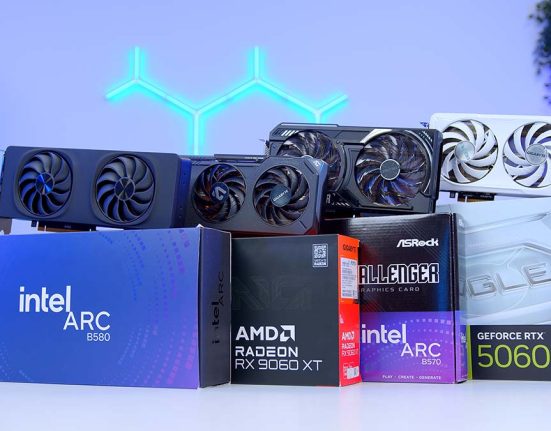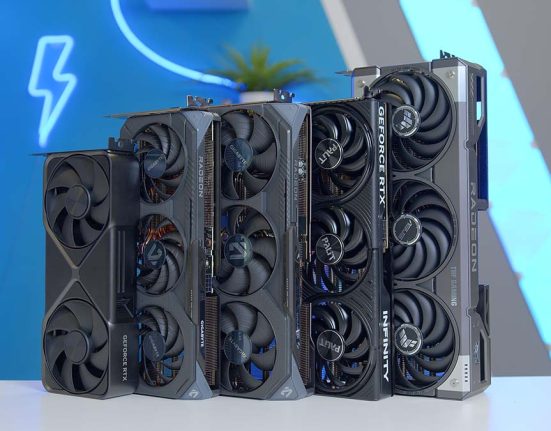The Gigabyte Z890 AORUS Elite WiFi7 is a mid-range motherboard with features that arrived alongside the Intel 15th-Gen series of CPUs. This board caters to those looking for high performance, offering PCI-E 5.0 support across the GPU and SSD slots and solid VRM power phases for overclocking. Prospective buyers also have access to high-speed IO, including Thunderbolt 4 and WiFi 7 support, alongside other excellent features. To determine how beneficial these additions are, we’ve put this board to the test, analysing the Z890 AORUS Elite WiFi7’s features, specs, and design.
The Z890 AORUS Elite WiFi7 motherboard is part of Intel’s 15th-Gen range, which utilises the LGA1851 socket, codenamed ‘Meteor Lake’. It’s been around three years since the release of LGA 1700, which changed the game for Intel by introducing DDR5 and PCI-E 5.0 support and clock speeds that we’d never seen before. It’ll be interesting to see how this Gigabyte Z890 board compares to its predecessor, as we can determine if there have been any significant generational improvements.
As always, with our motherboard reviews, we’ll inspect the critical elements of this board and examine the specs, box accessories, design, connectivity headers, and features in depth.
Buy the Gigabyte Z890 AORUS Elite WiFi7 on:
Specification
Compared to the Gigabyte Z790 AORUS Elite AX, we immediately noticed the RAM overclocking support on the Z890 AORUS Elite WiFi7. Intel has bumped the speeds up to 8800MT/s, with this board supporting a max capacity of 256GB, compared to the 7600MT/s cap on the Z790 variant. While these kinds of RAM speeds will cause stability issues, enthusiasts will likely be able to push the RAM further at lower speeds to enjoy some solid performance improvements. As for VRM power phases, the 16+1+2 configuration is the same as the Z790 AORUS Elite AX, but this will still allow you to push your CPU with a modest overclock.
The form factor hasn’t changed generationally. This Z890 version has retained the ATX sizing, which means it is commonly supported in the vast majority of cases. As we’ve seen across the AMD X870 range, there seems to be a push away from E-ATX boards, which is good to see because the cases that house these can be pretty cumbersome.

PCI-E connectivity has seen a marginal improvement. The vast majority of Z790 boards only had one Gen5 graphics card slot and lacked Gen5 SSD support. However, the Z890 AORUS Elite WiFi7 now offers Gen5 SSD bandwidth, allowing builders to leverage higher speeds. The rest of the board expansion options are similar to the Z790 version, with one Gen5 GPU slot and three additional Gen4 M.2 slots.
Connectivity on the front and the rear haven’t changed drastically between generations. The big takeaway here is that instead of using more USB 3.2 Gen2 ports, the Z890 AORUS Elite WiFi7 has Thunderbolt 4. Again, this is something we’ve seen across the X870 options due to more available bandwidth. Otherwise, the IO is similar. Four headers are on the front (one USB 3.2 Gen2 Type-C, one USB 3.2 Gen1 Type-A, and two USB 2.0), and on the rear, there are ten ports. The port selection is the same as the Z790 board, bar the fact that the USB 3.2 Gen2x2 port is now Thunderbolt 4 Type-C.
| Specification | Gigabyte Z890 AORUS Elite WiFi7 |
|---|---|
| Form Factor | ATX |
| Supported Memory | 256GB DDR5 8800MT/s |
| PCI-E x16 Slots | 1 x PCI-E 5.0 2 x PCI-E 4.0 |
| PCI-E x4 Slots | 1 x PCI-E 5.0 3 x PCI-E 4.0 |
| VRM Power Phases | 16+1+2 |
| Front IO | 1 x USB 3.2 Gen2 Type-C 1 x USB 3.2 Gen1 Type-A 2 x USB 2.0 |
| Rear IO | 1 x Thunderbolt 4 Type-C 2 x USB 3.2 Gen2 Type-A 3 x USB 3.2 Gen1 Type-A 4 x USB 2.0 |
| Audio | 1 x Optical S/PDIF 2 x Audio Jacks |
| Networking | 2.5 Gigabit LAN WiFi 7 |
One significant change with new motherboards is that they offer WiFi 7 instead of 6E. While you’ll need a supporting router, WiFi 7 is more stable and provides better bandwidth, which is a solid improvement compared to the previous generation. It’s also worth noting that the Z890 AORUS Elite WiFi 7 provides 2.5 Gigabit LAN for high-speed wired networking. The audio is decent, albeit rudimentary. There are two 3.5mm jacks for in and out connections and optical S/PDIF, catering to those with a speaker setup.
What’s in the Box?
In our motherboard reviews, we examine the box accessories before examining the board’s design or features. Manufacturers often include additional gadgets or cables to streamline the building process, so it’s worth highlighting these before delving further into the details of the board.
First off is the WiFi 7 antenna. If a board features onboard WiFi, it will come with an antenna that is recommended to be plugged in so you can enjoy a more extended range. The Gigabyte WiFi 7 antenna isn’t massively different in design, apart from the connectors, which feature a snap-in mechanic instead of screws, making it easier to install or remove.

The rest of the box accessories are pretty basic. Gigabyte has included a Q-connector that your front panel cables will plug into. Admittedly, Q-connectors are a bit redundant today as most modern cases use a single header for front panel power wires. However, if your case doesn’t, this Q-connector will be handy to keep a hold of.

There are also two SATA cables. Again, SATA storage isn’t as popular as NVMe SSDs, but if you still use a couple of SATA drives, the included cables make them easy to plug in.

Gigabyte Z890 AORUS Elite WiFi7 Design
The Z890 AORUS Elite WiFi7 is simple in terms of design. Gigabyte’s ‘Elite’ range has always been more simplistic in design than other boards around this price point. This means it isn’t particularly flashy regarding RGB, it isn’t covered in a mass of heatsinks, and much more of the PCB is exposed. This being said, I like the design of the Z890 AORUS Elite WiFi7.

The Z890 and Z790 versions look pretty similar, but there are a few distinct changes that distinguish them. The rear IO heatsink now features a small AORUS text strip that lights up with RGB when the board is powered.

The heatsink towards the centre of the board spans most of the width of the PCB instead of only covering the middle. This means heat dissipation will be slightly better, while the aesthetic looks more refined. This heatsink is also entirely tool-less, making removing and installing SSDs easy with minimal hassle.
There’s also a small strip of RGB underneath the heatsink on the right-hand side of the board, again adding some flair to the design. This can also be customised with RGB lighting software such as SignalRGB.

Overall, I think the board is designed well. It feels sturdy and robust, and the aesthetic is an adequate fit for most gaming PCs. However, the look isn’t going to blow you away.
As this board is primarily geared towards mid-range systems, Gigabyte has likely made some cost-saving measures, and design is one of the first things to go. The Z890 AORUS Elite WiFi7 looks reasonably similar to its Z790 counterpart, with contrasting grey and black heatsinks. It easily blends in with a darker setup, and the extra RGB is a nice touch.
Connectivity Options
Graphics Card Slots
There’s not much to cover on the expansion front, primarily because the Z890 AORUS Elite WiFi7 is similar to the Z790 AORUS Elite AX board. This board offers a single full-speed x16 slot, supporting Gen5 bandwidth, ready for the next generation of graphics cards. Two additional x16 slots run at Gen4 x4 speeds, so these are great expansion slots for more storage or extra USB ports.

M.2 Slots
On the storage front, it’s great to see the inclusion of Gen5 storage on this generation of boards, as the vast majority of Z790 options didn’t offer this. The Gen5 slot is underneath the heatsink, below the CPU socket. This heatsink is tool-less and held in by the Gigabyte EZ-Latch.

The three additional Gen4 M.2 slots are underneath the larger heatsink towards the middle of the board. Again, all slots are tool-less, allowing you to install and remove drives with little hassle.
RAM DIMMs
The Gigabyte Z890 AORUS Elite WiFi7’s RAM spec is quite impressive. The LGA1851 platform allows builders to overclock RAM up to 8800MT/s, which I imagine will be higher with boards geared towards enthusiasts.

As for the RAM configuration, this board supports a maximum of four 64GB DDR5 DIMMs with a maximum capacity of 256GB, which is standard across all LGA1851 boards.
Rear IO
The rear IO of the Z890 AORUS Elite WiFi 7 is decent for a board of this calibre. Still, as we mentioned in the specs section of this article, the port selection is pretty similar to that of the Z790 AORUS Elite AX. There are ten ports: one Thunderbolt 4 Type-C port, two USB 3.2 Gen2 Type-A ports, three USB 3.2 Gen1 Type-A ports, and four USB 2.0 ports.
It’s good that there’s a decent number of ports to choose from, even if they have been bulked out with USB 2.0. However, it would have been ideal if this board had more high-speed options. One of the main pros of the X870 motherboards is that there is pretty much no USB 2.0 in sight, even on some of the lower-end options, which would make the Z890 AORUS Elite WiFi7 stand out more.

The rear IO options are decent, but again, this board is very similar to the Z790 AORUS Elite AX. There is a 2.5 Gigabit LAN port for wired internet or WiFi 7, which offers solid speeds if you have a supporting router. For audio, there are two 3.5mm jacks (mic-in, line-out) and optical S/PDIF.
Internal Headers
CPU and Motherboard Power
Moving onto the internal headers, the power configuration on the Z890 AORUS Elite WiFi7 is the same as the Z790 version. There are two 8-pin EPS CPU connectors for CPU power. You don’t need to plug in both, but we recommend doing so as power delivery is spread better, improving thermals.

This board uses a 24-pin connector on the right side of the PCB for motherboard power. Gigabyte hasn’t included an additional 8-pin PCI-E on this board, but this may be different with high-end options.

Front USB Headers
The front USB is relatively basic compared to other boards we’ve reviewed. There are four headers: two USB 2.0, one USB 3, and one Type-C. The USB 3.2 Gen Type-C header sits just beneath the motherboard power and can only be plugged in one way.

The USB 3.2 Gen1 header supports two ports and is just below the USB Type-C headers. These cables have a small notch in the middle, indicating the correct orientation for plugging them in.

Finally, two USB 2.0 headers support two ports, each directly below the final PCI-E x16 slot. It’s a shame there aren’t more of these, as coolers and fans can use them up pretty quickly.

Pump and Fan Headers
This motherboard has a decent selection of 4-pin PWM headers. At the top of the board, you’ll find a ‘CPU_Fan’ and ‘CPU_Opt’ headers, primarily reserved for a cooler. To the left of these, next to CPU power, is ‘SYS_Fan5’, typically used for case fans.

On the right-hand side of the board, below the motherboard power, is ‘FAN4_PUMP.’ This can be used for either a case fan or an AIO (all-in-one) liquid cooler. However, if reaching this header is too much of a stretch for an AIO, then the ‘CPU_Fan’ header doubles as a pump header.

Finally, the remaining two ‘SYS_Fan’ headers are at the bottom right of the motherboard, to the left of JFP1 power. There are plenty of 4-pin headers to use here, and they’re all located in sensible spots on the outside of the PCB, making them easier to access.
RGB Headers
The selection of RGB headers is pretty standard. There are three 3-pin addressable headers and one 4-pin non-addressable header. One of the 3-pin headers is at the top right of the board, alongside the 4-pin fan control.

The final three are all in the same spot, towards the bottom left of the motherboard. It would be nicer to see an extra addressable header, as it opens options for those looking to plug in RGB strips or additional lighting. However, the four on this board will be more than ample for most.
SATA Data Ports
While SATA is an older storage medium, many PC veterans still use SATA-based SSDs or hard drives. Fortunately, Gigabyte has included four SATA data ports towards the bottom-right of the board, allowing you to plug in these drives.

Building with the Z890 AORUS Elite WiFi7
Much like with the selection of X870 motherboards that we’ve reviewed, the Z890 AORUS Elite WiFi7 offers a similar story in terms of build quality and experience. There’s been a massive push for usability and DIY-friendly features on all new boards, meaning the vast majority are tool-less. This means installing SSDs and graphics cards requires no screwdrivers or tiny screws.

We’re hugely thankful for this because we build so many PCs on a day-to-day basis, and these usability features streamline the process. Additionally, it means the boards are generally more resilient, as we’re not threading screws or over-tightening them. It’s great that the Z890 AORUS Elite WiFi7 has retained the ATX form factor because it meant installing it inside a case didn’t cause any clearance issues.
Seeing single push-tab RAM slots would have been nice, but this isn’t a deal-breaker for us. Overall, building with the Z890 AORUS Elite WiFi7 was a solid experience, and we’re hoping that other boards follow suit.
Features We Like
Tool-Less Features
As mentioned earlier, almost all of the new boards from AMD and Intel have a more significant focus on making the building experience hassle-free. This means there are more tool-less slots, minimising the use of screwdrivers and screws across your build.

For example, the primary SSD slot heatsink can be removed by pushing down on the latch. Any M.2 drive installed here is then pushed down and clicked into place with no screws required. The graphics card also has a big button to lower the latch, making it easy to remove.
Better RAM Overclocking
I was surprised to read this motherboard’s specs and find that its RAM overclocking support immediately surpasses AMD X870. RAM speeds on this board can reach a maximum of 8800MT/s, 600MT/s more than some of the top-end X870E options. This is a pretty impressive feat for what’s considered a mid-range motherboard.

Features We Don’t Like
Needs Better Gen5 SSD Support
While I appreciate that the Z890 AORUS Elite WiFi7 now supports a singular Gen5 SSD, it should realistically support more. The Z890 is Intel’s crème de la crème chipset, which means these boards should be best equipped for solid mid-range and high-end builds. However, offering only one Gen5 SSD slot feels a bit cheap when the X870 version of this exact board has three of these slots.

Bulked Out With USB 2.0 Ports
One of my criticisms of the Z790 version of this board is that it has too many USB 2.0 ports, and this argument still stands for the Z890 iteration. Again, as a board on Intel’s most performance-focused chipset, the Z890 AORUS Elite WiFi7 should have more high-speed ports.

Conclusion
Gigabyte Z890 AORUS Elite WiFi7
Product Name: Z890 AORUS Elite WiFi7
Brand: Gigabyte
-
Features
-
Design
-
Performance
-
Value For Money
Summary
The Gigabyte Z890 AORUS Elite WiFi7 is a mid-range motherboard on the Z890 chipset that offers some decent improvements over its Z790 counterpart. With the arrival of the LGA1851 socket, the Z890 AORUS Elite WiFi7 offers better RAM speeds, plenty of usability features to streamline the PC building process, and support for WiFi7. The board is designed well, provides a nice aesthetic, customisable RGB lighting, and a range of tool-less mechanisms that I’m a massive fan of.
Unfortunately, this board’s biggest weakness is its similarity with the Z790 AORUS Elite AX, a previous-generation option. There aren’t many improvements to this board compared to the Z790 version, which means that, for the most part, the connectivity and expansion options are more or less the same. As this is on a new platform with a new generation of CPUs, the Z790 AORUS Elite AX should offer a more enticing set of features to attract prospective buyers to make the generational leap. This becomes even clearer when we compare this to an X870 board, which offers some significant changes compared to the previous X670 chipset.
Pros
✅ DIY-friendly features
✅ Improved RAM overclocking
✅ WiFi7 support
Cons
❌ Bulked out with USB 2.0
❌ Weak Gen5 SSD support
❌ Similar to Z790 version


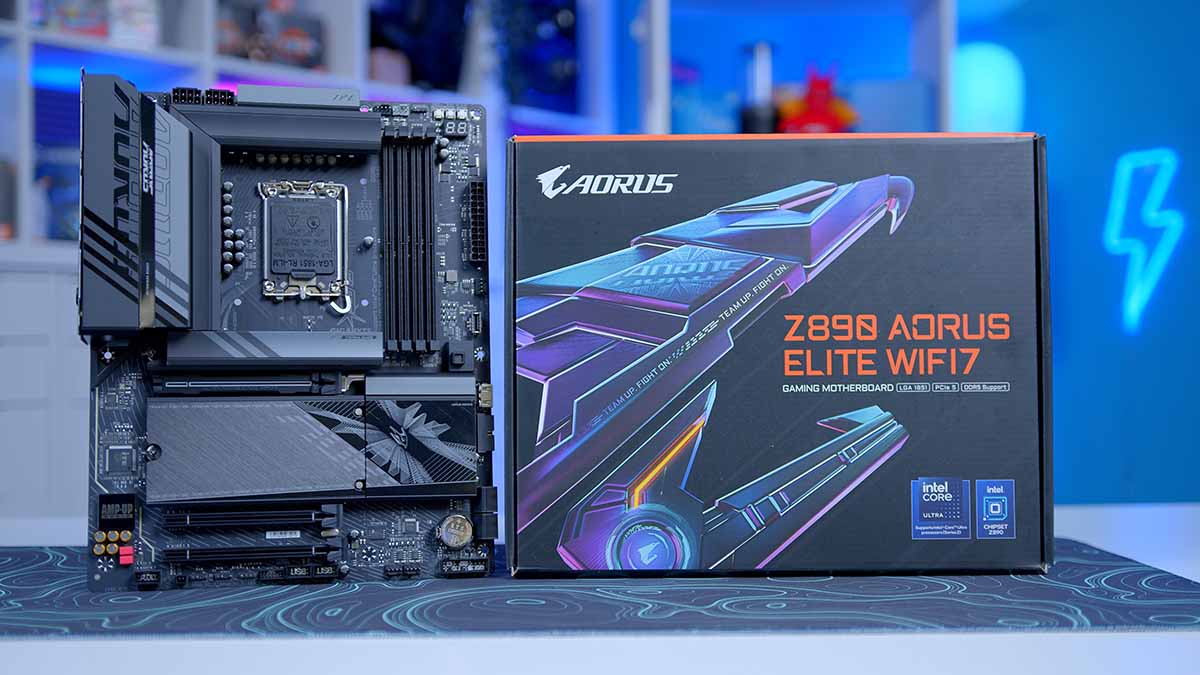
![FI_[DM78] Corsair Air 5400 + 5090 Gaming PC Build](https://geekawhat.com/wp-content/uploads/2025/11/FI_DM78-Corsair-Air-5400-5090-Gaming-PC-Build-551x431.jpg)
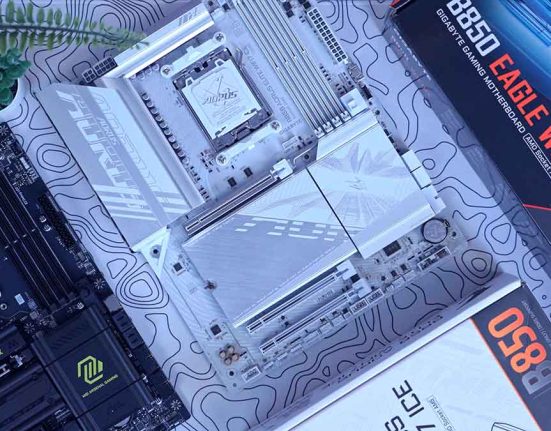
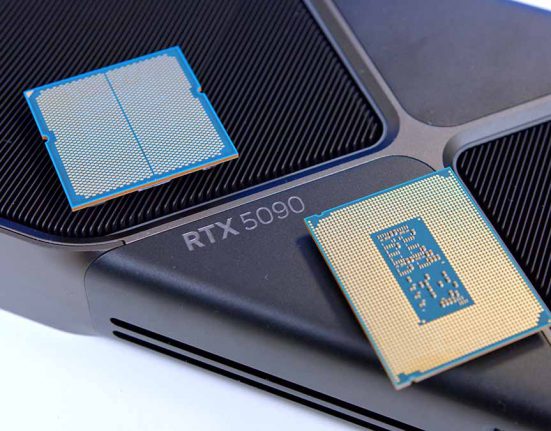
![FI_[DM76] HAVN BF360 5090 Build](https://geekawhat.com/wp-content/uploads/2025/10/FI_DM76-HAVN-BF360-5090-Build-1-551x431.jpg)
